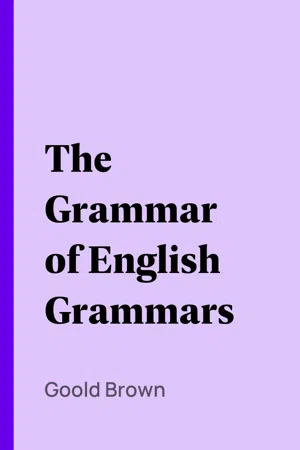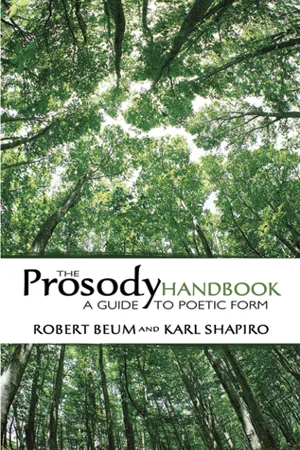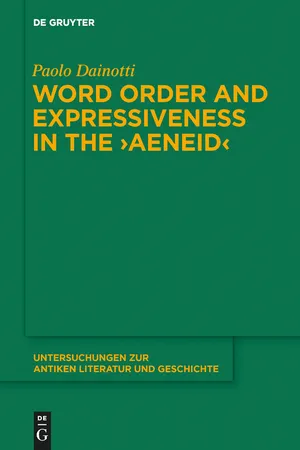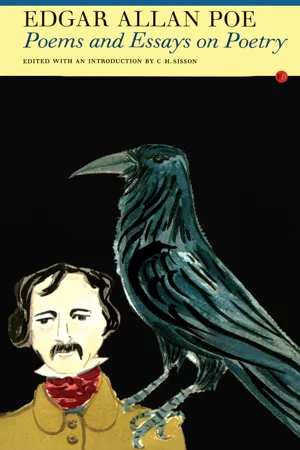Literature
Spondee
A spondee is a metrical foot in poetry consisting of two stressed syllables. It is often used to create a sense of emphasis or weight in a line of verse. Spondees can be found in various forms of poetry and are used to create rhythm and impact in the language.
Written by Perlego with AI-assistance
4 Key excerpts on "Spondee"
- eBook - ePub
- Goold Brown(Author)
- 2004(Publication Date)
- Perlego(Publisher)
Antibacchy.Few, if any, of these feet are really necessary to a sufficient explanation of English verse; and the adopting of so many is liable to the great objection, that we thereby produce different modes of measuring the same lines. But, by naming them all, we avoid the difficulty of selecting the most important; and it is proper that the student should know the import of all these prosodical terms.5. A Spondee is a poetic foot consisting of two long syllables; as, c=old n=ight, p=o=or s=ouls, ~am~en, shr=ovet=ide.6. A Pyrrhic is a poetic foot consisting of two short syllables; as, presumpt-|~uo~us, perpet-|~u~al, unhap-|p~il~y, inglo-|r~io~us.7. A Moloss is a poetic foot consisting of three long syllables; as, De~ath's p=ale h=orse,—gre=at wh=ite thr=one,—d=eep d=amp v=a=ult.8. A Tribrach is a poetic foot consisting of three short syllables; as, prohib-|~it~or~y, unnat-|~ur~all~y, author-|~it~at~ive, innum-|~er~abl~e.9. An Amphibrach is a poetic foot of three syllables, having both sides short, the middle long; as, ~impr=ud~ent, c~ons=id~er, tr~ansp=ort~ed.10. An Amphimac, Amphimacer, or Cretic, is a poetic foot of three syllables, having both sides long, the middle short; as, w~ind~ingsh=eet, l=ife-~est=ate, s=oul-d~is~eased.11. A Bacchy is a poetic foot consisting of one short syllable and two long ones; as, th=e wh=ole w~orld,—~a gre=at v=ase,—=of p=ure g=old.12. An Antibacchy, or Hypobacchy, is a poetic foot consisting of two long syllables and a short one; as, kn=ight-s=erv~ice, gl=obe-d=ais~y, gr=ape-flow~er, g=old-b=eat~er.Among the variegations of verse, one emphatic syllable is sometimes counted for a foot. "When a single syllable is [thus] taken by itself, it is called a Cæsura - eBook - ePub
The Prosody Handbook
A Guide to Poetic Form
- Robert Beum, Karl Shapiro(Authors)
- 2012(Publication Date)
- Dover Publications(Publisher)
Consequently, there are few or no true Spondees in English verse. But notice in the lines above, from Yeats’s “Among School Children,” that the stresses on the syllables of the third and fourth feet of the first line, and of the fourth foot of the second line, are more nearly Spondees than iambs. It is not really important, however, to be concerned about the feet. What is important is to notice that the four consecutive stresses (three primary and one secondary, perhaps) of the first line slow the rhythm to match the sense beautifully. The speaker, an old man who has come as a public official to inspect a school, is walking through a long room, and he is moving, of course, unobtrusively and with deliberate care. In a, the third foot of the second line, is as pure a pyrrhic as one will find in English verse. Notice that the Spondee follows immediately. The Spondee-pyrrhic or pyrrhic-Spondee is one of the commonest variations of iambic meter. Some prosodists prefer to think of the situation as a four-syllable foot called an IONIC. This is a small point. Notice that the stress on through is very light. Compare it with walk or kind. Should we call through the a pyrrhic or a trochee? The final syllable of questioning is also extremely light, perhaps lighter than through. The constantly varying degree of stress, as we have already noted, is one of the glories of English rhythm; the variation in itself helps prevent monotony in lines otherwise perfectly regular. - eBook - ePub
- Paolo Dainotti, Ailsa Campbell(Authors)
- 2015(Publication Date)
- De Gruyter(Publisher)
604The spondaic line-end can moreover reinforce the semantics of a noun indicating extension or duration, as at Aen .5.318 ff.primus abit longeque ante omnia corpora Nisusemicat et uentis et fulminis ocior alis;proximus huic, longo sed proximus interuallo ,insequitur Salius;where the sequence longo interuallo is powerfully underlined by the heavy and slow rhythm of the spondaic line-end: Salius is closest to Nisus, but follows him only after a lengthy distance.605 Also noteworthy in this sense is B .4.48 f.adgredere o magnos (aderit iam tempus) honores,cara deum suboles, magnum Iouis incrementum !where the spondaic line-end, converging with other stylistic devices (epiphonema, the hyperbaton magnos … honores , and the polyptoton magnos … magnum ) lends solemnity to the language, and implicitly underscores the sense of growing increase in the semantics of incrementum .606D) Stylistic effects of the disposition of caesurae
In the main commentaries on the Aeneid there is no lack of observations on the collocation of caesurae in a verse.607 Such remarks rest upon a variety of evidence in the text: the Latin hexameter tends to make the syllable in arsi coincide with the word accent in the last two feet, unlike in the first four feet,608 so as to avoid the sequence of long monosyllable + spondaic word after the penthemimeral (2½) (Marx’s Law),609 to avoid a double break at fourth and fifth trochee,610 and to avoid having a third foot trochaic caesura which is not associated with masculine caesurae.611We shall make a distinction between those instances which present a dearth of masculine caesurae and those in which such caesurae converge with a marked spondaic rhythm.D) I a Lines with a dearth of masculine caesurae
From stylistic point of view it is important to note that verses which lack masculine caesurae have similarity of theme and motif. In a first category of instances – which we can define as ‘narcotic lines’ – the dearth of masculine caesurae lends the verse a languid rhythm, reinforcing the idea of sleep or death expressed by the semantics of the terms.612 Typical of these instances is Aen - eBook - ePub
Edgar Allan Poe
Selected Poems and Essays
- Edgar Allan Poe, C.H. Sisson(Authors)
- 2023(Publication Date)
- Routledge(Publisher)
That this latter can properly estimate or decide on the merits of what is called scientific music, is of course impossible. But scientific music has no claim to intrinsic excellence – it is fit for scientific ears alone. In its excess it is the triumph of the physique over the morale of music. The sentiment is overwhelmed by the sense. On the whole, the advocates of the simpler melody and harmony have infinitely the best of the argument; – although there has been very little of real argument on the subject. In verse, which cannot be better designated than as an inferior or less capable Music, there is, happily, little chance for complexity. Its rigidly simple character not even Science – not even Pedantry can greatly pervert. The rudiment of verse may, possibly, be found in the Spondee. The very germ of a thought seeking satisfaction in equality of sound, would result in the construction of words of two syllables, equally accented. In corroboration of this idea we find that Spondees most abound in the most ancient tongues. The second step we can easily suppose to be the comparison, that is to say, the collocation, of two Spondees – of two words composed each of a Spondee. The third step would be the juxta-position of three of these words. By this time the perception of monotone would induce farther consideration; and thus arises what Leigh Hunt so flounders in discussing under the title of ‘The Principle of Variety in Uniformity’. Of course there is no principle in the case – nor in maintaining it. The ‘Uniformity’ is the principle: – the ‘Variety’ is but the principle’s natural safeguard from self-destruction by excess of self
Index pages curate the most relevant extracts from our library of academic textbooks. They’ve been created using an in-house natural language model (NLM), each adding context and meaning to key research topics.
Explore more topic indexes
Explore more topic indexes
1 of 6
Explore more topic indexes
1 of 4



